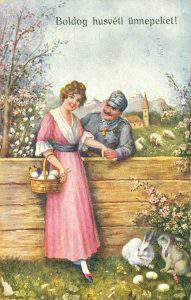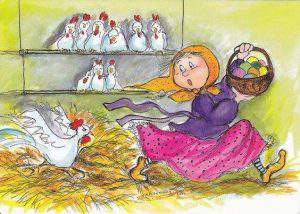How Hungarians celebrated Easter back in the day

Did you know that “you could even smell the violets of Gellért Mountain in the city” 120 years ago? And that “the bells of Pest and Buda sounded differently in springtime”? Index.hu cites the thoughts of Gyula Krúdy, a famous Hungarian writer, who – among others – wrote about the springs and Easters at the turn of the century. Let’s recall how Hungarians celebrated Easter back in the day 🙂
As the saying goes, so many countries, so many customs. This is also true for different regions, eras, but traditions even differ by families. Especially in the case of Easter. We have previously shared articles about Easter traditions in Hungary, and also the important role superstitions play in the festivities. But for now, we want to take you on a little journey in time with quotes from Gyula Krúdy and newspapers that illustrate how Hungarians used to celebrate Easter.
“For a few weeks, the shop-windows of confectioneries have been showing that this is the joyful celebration of red eggs, but the red eggs of Budapest are only reminiscent of the real, countryside eggs, in their shape. No lady boiled them and painted them red, they are not even decorated with strange shapes, and they have nothing to do with hens. They were made in the factory, from sugar, silk paper and painted wood. Some of them have small windows, with hens, and their chicks inside, while others can be opened, and a baby or a bunny smiles at you from the inside. A cavalier flatters his female acquaintances with decorated eggs, parents buy less decorated ones for their children, but the joy it gives them is probably the greatest and the most sincere.” (Vasárnapi Ujság, 1903)
The Grand Boulevard used to be the heaven of these “panorama eggs”. A row of confectioneries sold sugar eggs and their rival: sugar sheep. A good egg was also able to reflect world politics. For instance, in 1939, not long before the outbreak of WWII, a tiny warship and a bomb-dropper was hidden inside the eggs.

Postcard from 1950 (Zempléni Múzeum)
“The habit of sprinkling women is not as widespread in Pest as it is in the countryside, but the trade of pharmacies always increases before Heaving Monday, because the cavaliers and fops of Pest went to fill up their small bottles with cologne rose water.”
There was a more playsome way of sprinkling, with which young ladies came up: they made the gentlemen smell an object that looked like a bouquet, but it was actually a spray, which poured water all over their face. It might be incredible, but some factories already produced creations like this in the 1870s.
“Do you, dear reader, remember the trend in Pest, when everyone put on new clothes for Easter? Even though the city wasn’t receptive to superstitions and people only stuck to traditions that were pleasant, enjoyable and affordable to them, like Easter ham and sprinkling, no one gave up new clothes for the feast. Anyone who wanted to look like a decent person bought new clothes for Easter.” (Gyula Krúdy: The last chime)

Postcard from 1910
Some people took this so seriously that others complained that the processions of resurrection around the churches of Pest were basically the fashion shows of women, who wanted to show off their new clothes.
At Easter-time, all restaurants and cafés of the City Park and the Margaret Island put out fences painted green, metal tables and chairs, even if the weather didn’t look like it was spring. On the Gellért Mountain, carnival people and gingerbread-makers mounted tents when Easter came.
This was also when people went on excursions to nearby forests, but some people went even further.
According to an 1892 issue of Budapesti Hírlap, around Easter “all fathers turned into simple vehicles”, because it was time for them to take the kids on excursions. “Sunday family men are the most patient vehicles, because even horse are trained to signal when they are full overloaded, but this is not something that Sunday family men can do.”
“In the city centre, spring fever mostly manifested in men thinking about how they could steal some money for the Easter trip. It was like the whole city wanted to leave Pest around Easter. Local citizens, who claim to make money by sitting in cafés every day and live off of the garbage of card-tables in the winter, come up with a plan that is honoured with prison by the court: before Easter they run around with banknotes to buy train tickets.” (Gyula Krúdy)
People’s traveling desire was supported by the Budapest Ticket Office which organised special trips with the destination of Fiume. According to Sunday Journal, “they took excursionists there and back, catered for them for 36 forints. 260 people took part in the trip to Fiume” in 1886.

To finish the recollection and get you in the mood for the holiday, we’d like to share Sándor Márai’s thoughts on celebrations and festivities:
“Get yourself clean on the inside and the outside as well. Forget the tasks of everyday life. Celebrations are not only written with red letters in the calendar. Look at our ancestors and how reverently, unconditionally and joyfully they celebrated! Celebration is unlikeliness. Celebration is deep and magical irregularity. Let the celebration be celebratory. Let it be filled with dance, flowers, young ladies, delicious food and beverages that warm the heart. And most importantly, let it have something from the old traditions, the seventh day, interruption, total relaxation and let it be reverent and unconditional. Celebration is the class of life, its higher sense. Get ready for it in your body and soul.” (Excerpt from Sándor Márai’s Herbario)
Photos: www.facebook.com/ZempléniMúzeum, Húsvét
Featured image: Wiki Commons by By Jellinek – Pruzsina Rózsa
Ce: bm
Source: http://index.hu/





